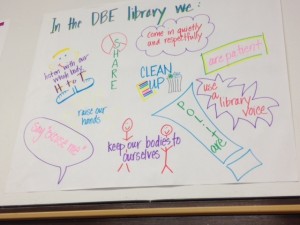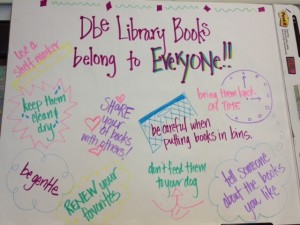2016 – 2017
January / February
 For most of January and February, Students in 101, 102, 103, 104 and 6 are becoming eBook authors. We are planning and preparing first in print. Each students is
For most of January and February, Students in 101, 102, 103, 104 and 6 are becoming eBook authors. We are planning and preparing first in print. Each students is  practicing upper and lower case letters, choosing a theme for their alphabet books and then recording one word for each letter in their planning document. Books range from garden books to Star Wars books and a whole lot of K and 1 inspiration in-between.
practicing upper and lower case letters, choosing a theme for their alphabet books and then recording one word for each letter in their planning document. Books range from garden books to Star Wars books and a whole lot of K and 1 inspiration in-between.
 After students have completed their planning documents they are moving into the Book Creator App to create their eBooks. Finished eBooks will be published on the library’s website.
After students have completed their planning documents they are moving into the Book Creator App to create their eBooks. Finished eBooks will be published on the library’s website.
October
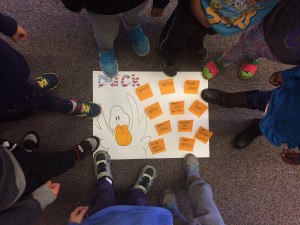 Our school-wide mock election has come to a close alongside our national presidential election. Thanks to Capstone Publications and PebbleGo for provided both the resources for our research and the platform through which our students voted.
Our school-wide mock election has come to a close alongside our national presidential election. Thanks to Capstone Publications and PebbleGo for provided both the resources for our research and the platform through which our students voted.
K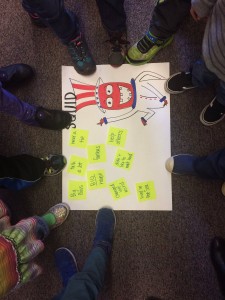 indergarten and first grade students began our unit by first comparing Duck for President with Squid for President. Students were asked to listen for key details in each story and then identify which details they thought would make a good President. When both stories had been read, qualities identified and the integrity of our voting process was discussed we then held a practice “foot poll” for students to vote.
indergarten and first grade students began our unit by first comparing Duck for President with Squid for President. Students were asked to listen for key details in each story and then identify which details they thought would make a good President. When both stories had been read, qualities identified and the integrity of our voting process was discussed we then held a practice “foot poll” for students to vote.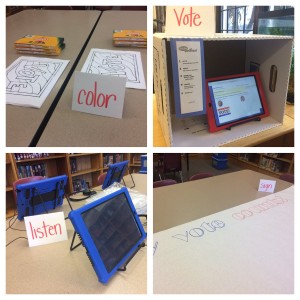
For candidate research we used PebbleGo exclusively for student research. PebbleGo has the capacity to allow our emergent readers to listen and follow along with text that is written for K-3 learners. After both candidates had been explored equally we then set up voting booths and students participated in our school-wide mock election.
2015-2016
29 February – 1 April – March Book Madness
For the second time, DBE Readers will be participating in a worldwide March Book Madness. Thanks to the Nerdy Book Club, all DBE readers have the opportunity to help seed (select) 16 participants (books) to compete in a bracket modeled after NCAA’s March Madness. The theme for 2016 is FANTASY vs. FICTION.
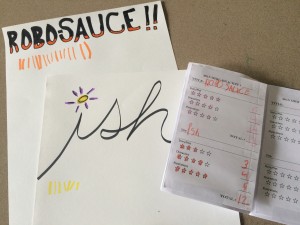 We are using classtime to READ BOOKS! It has be a phenomenally enjoyable experience for everyone and our students are at the perfect age to soak up the joys and wonders of picture books. Students are cheering for their favorite stories!
We are using classtime to READ BOOKS! It has be a phenomenally enjoyable experience for everyone and our students are at the perfect age to soak up the joys and wonders of picture books. Students are cheering for their favorite stories!
Brackets are available for Picture Books, Middle Grade Readers and Young Adult Titles. DBE Readers will be looking solely at the Pictures Books Bracket. Thanks to our DBE PTA, and their Special Initiatives Grant, we will have 3 copies of each MBM title available!
CCSS – RF.1.1, RF.K.1 We can demonstrate understanding of the organization and basic features of print.
October 15
Rm 103, along with Ms. Norton and I, are practicing what her Ks have described as “iPad Training.” While the phrase itself does, indeed, capture the essence of the time we are spending together each week it does fall quite short of the goals we have for our students during this time. Each week, Ms. Norton’s class comes to the library for 40 minutes. Our time together is intended to:
- teach, model and practice Digital Citizenship
- practice personal responsibility and independence
- navigate digital environments
Ms. Norton and I are very excited about some of the future plans we have the students of Rm 103. We are building a solid foundation for her students – a foundation that will serve them this year as Ks and well into their digitally rich futures.
2014-2015
May 18 – June 5
As our piece de resistance for this school year we will be spending 2 days using the iPads and the App Toontastic to complete our stories. Students began with character development and then moved into story arch design. Thanks to the vivid illustrations and engaging stories of David Shannon we had plenty of laughs and inspiration for the creation of our own stories.
CCSS – SL.K.5, SL.1.5 We can make strategic use of digital media and visual displays of data to express information and enhance understanding of presentations.
April 27 – May 15
In continuing our Author/Illustrator study of David Shannon, we are delighted to read the following books this week:
As a class we will be identifying the story arch of each story in preparation for our own story writing in Toontastic. We will be using the story arch as it is identified in Toontastic (Setup, Conflict, Challenge, Climax and Resolution). In our passports we will be writing and/or drawing the 5 elements of the story arch for our own individual stories.
CCSS – RL.K.2, RL.1.2 With prompting and support, we can retell familiar stories including key details.
RL.K.3, RL.1.3 With prompting and support, we can identify characers, settings, and major events in a story.
March 30 – April 24
Will are finishing our year off with another author/illustrator study. Our study of, Caldecott Medal Winning, David Shannon and his works are being used to guide our own main character development, story arch identification, and then final product using Toontastic. 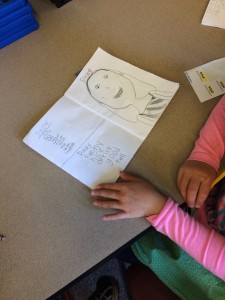
This week we are reading:
As a class we are using the Main Characters, David, Fergus and Duck to identify adjectives that describe our main characters. In our passports we are 1) drawing a picture of our own main characters and then using our, class created, word walls and best guess spellings to list adjectives/characteristics of our main characters.
CCSS – RL.K.2, RL.1.2 With prompting and support, we can retell familiar stories including key details.
RL.K.3, RL.1.3 With prompting and support, we can identify characers, settings, and major events in a story.
March 9 – 27
March Book Madness was a huge success. Congratulations to the winning book, “The Day the Crayons Quit” by Drew Daywalt. It was a tough competition. Students used a 5 star rating system to evaluate 3 criteria for each book (Story, Characters and Illustrations). 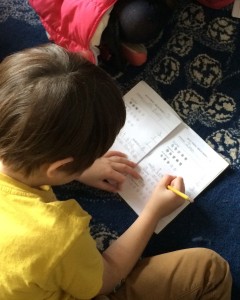
CCSS – RF.1.1, RF.K.1 We can demonstrate understanding of the organization and basic features of print.
February 18 – March 6
For the first time, DBE Readers will be participating in a worldwide March Book Madness. Thanks to the Nerdy Book Club, all DBE readers have the opportunity to help seed (select) 64 participants (books) to compete in a bracket modeled after NCAA’s March Madness.
We are using classtime to READ BOOKS! It has be a phenomenally enjoyable experience for everyone and our students sharing in the joys and wonders of picture books. Each student is starting with a list of their top ten from each side of the bracket. We are using that to calculate our totals and submit our school-wide response. Students are cheering for their favorite stories!
Brackets are available for Picture Books, Middle Grade Readers and Young Adult Titles. DBE Readers will be looking solely at the Picture Books Bracket.
If your student would like to submit their selections, independent of our school wide selections, they can simply use the Picture Books form and list their top ten titles for each of the 2 categories (2014 and before 2014).
CCSS – RF.1.1, RF.K.1 We can demonstrate understanding of the organization and basic features of print.
January 26 – February 13
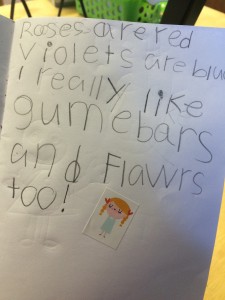 In order to reinforce out initial iPad lesson students are returning to the iPads this unit to write a poem, tinker in a couple of drawing apps and then use the App of their choice to create a digital Valentine.
In order to reinforce out initial iPad lesson students are returning to the iPads this unit to write a poem, tinker in a couple of drawing apps and then use the App of their choice to create a digital Valentine.
First, we are working to write our simple Valentines poems in our passports.
Roses are red,Violets are blue.
I really like ____,
and ____ too.
Once students have completed their poems we are spending some time “tinkering.” Giving students time to explore and test apps within a structured environment is very valuable. Students are directed to the Drawing folder on the iPad and then given time to explore and tinker within the 3 available apps.
- Drawing Desk – Draw, Paint, Doodle, Sketch by 4 Axis Solultions
- Drawing Free by ThumSoft
- Draw and Doodle Free by Feng Min
On our final day we are sharing our poems with each other, identifying 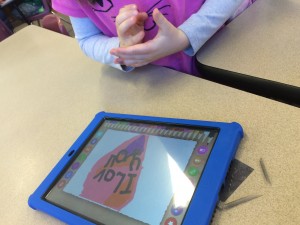 symbols and colors that symbolize Valentine’s Day and the using our drawing apps to create digital Valentines Cards.
symbols and colors that symbolize Valentine’s Day and the using our drawing apps to create digital Valentines Cards.
CCSS
W.K.6, W.1.6 – We can, with guidance and support from adults, explore a variety of digital tools to produce and publish writing, including collaboration with peers.
January 5-23
In January we are using our time together in the library to introduce and practice the use of a PED (Personal Electronic Device) as a tool while at school. In particular, we are fortunate enough to have a full class set of iPads available to us.
All DBE students, K-5, agree to the following:
I will only use the iPad for its
intended purpose.
And if I don’t,
I will not use the iPad.
While the use of technology to enhance, enrich and support our work as students is vital to our growth as 21st century digitial citizens, it still stands that the use of the iPads at DBE is a privilege and not a right. The agreement above, coupled with our conversations in class prior to using the iPads illustrates how our use of PEDs at home is often guided by different principles than our use of PEDs at school. We draw the line between home/entertainment and school/education.
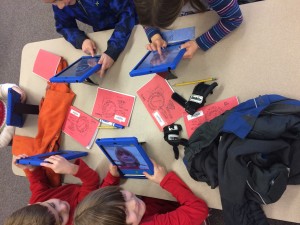 Each grade level is using the iPads in different ways to practice our in school protocols and procedures. Every students is assigned an iPad color and number that will be their iPad for the remainder of the school year. This helps to streamline distribution and collection as well as follow up with a user when an iPad has any issues regarding condition or content.
Each grade level is using the iPads in different ways to practice our in school protocols and procedures. Every students is assigned an iPad color and number that will be their iPad for the remainder of the school year. This helps to streamline distribution and collection as well as follow up with a user when an iPad has any issues regarding condition or content.
Our K/1s are using this time to acclimate themselves to a library that offers them access to iPads as a resource. In order to do this we are using Chatterpix as a beginning App. Students are creating their own Chatterpix and recording “I like library because…” Chatterpix is an App that animates a mouth using a student’s 30 second recording. Students are able to drag, drop and resize images as well as return to edit their product. In addition, the use of one specific App reinforces our agreement to “only use the iPad for its intended purpose.
If you have questions or concerns about student use of iPads at DBE, please feel free to contact me: rlwynkoop@seattleschools.org.
December 1-19
Snow! Snow! Snow! The weather has indeed been chilly enough to elicit thoughts of snow. For two years running we have been fortunate enough to have a sprinkling of snow somewhere during our SNOW unit. I’ll keep my fingers crossed this year will be just as magical.
We are using a number of resources to aid in our research of snow, including:
- Flakes and Fluries: A Book About Snow by Joseph Sherman
- No Two Alike by Keith Baker
- Snow by Uri Shulevitz
- Waiting for Winter by Sebastian Meschenmoser
- Outside by Deidre Gill
- Snowflakes: A Pop-Up Book by Jennifer Preston Chushcoff
- Snowflake Bentley
- The Science of Snowflakes
- Snowflake Bentley Video by Mr. Cs fourth graders
In addition to using our Passports to record new knowledge (via pictures and writing) students will be given an opportunity to create their own, one of a kind, snowflake that will be used to spruce up the library through December, January and February.
CCSS RI.1.9, RI.K.9 – Identify basic similarities in and differences between two texts on the same topic.
November 3 – 21
 For our November unit we are preparing ourselves as readers for a visit from a real, live, author and illustrator, Julie Paschkis! In October, while with Ms. McNeer for art, Ks and 1s were studing chickens. Ms. Paschkis’ book Mrs. Chicken and the Hungry Crockodile was one of many books and materials students used when drawing their chickens.
For our November unit we are preparing ourselves as readers for a visit from a real, live, author and illustrator, Julie Paschkis! In October, while with Ms. McNeer for art, Ks and 1s were studing chickens. Ms. Paschkis’ book Mrs. Chicken and the Hungry Crockodile was one of many books and materials students used when drawing their chickens.
Ms. McNeer has contacted Ms. Paschkis and she is coming to talk with our Ks and 1s about her jobs as both an author and an illustrator. During library time we are identifying the different roles of both the author and the illustrator as well as diving deeply into many of Ms. Paschkis’ works:
- Apple Cake: A Recipe for Love
- Fat Cat: A Danish Folktale
- The Talking Vegetables
- Mooshka: A Quilt Story
In addition to preparing our Passports for Ms.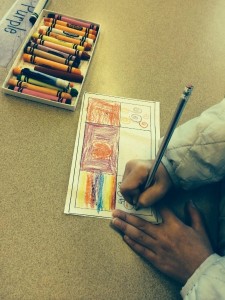 Paschkis’ visit, we are designing our own Mooskas (quilts) – each with 6 different schnitzs (a quilt block that tells a story).
Paschkis’ visit, we are designing our own Mooskas (quilts) – each with 6 different schnitzs (a quilt block that tells a story).
CCSS RL.K.6 With prompting and support, name the author and illustrator of a story and define the role of each in telling the story.
RL.1.7 Use illustrations and details in a story to describe its characters, setting, or events.
October 13 – October 31
 It was delightful to spend one day this week coming back to our research from our previous visit. We were able to embed math, science and literacy into our research!
It was delightful to spend one day this week coming back to our research from our previous visit. We were able to embed math, science and literacy into our research!
A survey of all 6, K and 1 classes revealed that 78 students prefer cats while only 48 students prefer dogs. We used giant tally marks to visually represent our findings and prove that indeed 78 is BIGGER/MORE than 48.
We read Hondo and Fabian by Peter McCarty as a way to bring our two separate topics (Dogs and Cats) together and spent a little of time finishing our Passport Dog and Car pages.
Our second day began with reading Los Gatos Black on Halloween by Marisa Montes. This book provided a perfect transition from our Dog/Cat research to our annual “Literary Pumpkins” project.
Every year students spend one day in the library turning their blank pumpkins into one of their favorite literary characters. Pumpkins swiftly transform into Gerald and Piggie, Mo Willem’s Pigeon, Chester the Cat, Monkey with a Tool Belt and many others! For additional character inspiration we also read Tobias and the Super Spooky Ghost Book by Tom Percival.
CCSS
RL.K.1.3, RL.1.3 We can describe characters using key ideas and details.
September 22 – October 10
Super Secret Research – they didn’t even know we were doing research! For this unit our Ks and 1s are exploring their prior knowledge with regard to both Cats and Dogs. After we read 3 stories related to each topic, we then recorded our NEW knowledge collectively.
For our cat study we read:
How to Be a Cat by Nikki McClure
Posy by Linda Newberry and Catherine Rayner
Calliou and Gilbert by Joceline Sanschagrin (via Tumblebooks)
For our dog study we read:
Wag! by Patrick McDonnell
Dogs by Emily Gravett
I Got Two Dogs by John Lithgow (via Tumblebooks)
CCSS
RI.K.1, RI.1.1 We can ask and answer questions about key details in a text.
September 1-19
Library Schedules have changed this year!
First, all school library checkout will occur on Tuesdays! Students should bring back their books for collection Tuesday mornings and families should be able to ask “What new book did you check out of the library?” at the end of the day.
Second, the DBE PCP schedule (visits to Art, PE, Tech, and Library) has moved to an ABC rotation. One week your student will attend art 5 days a week for 40 minutes, then PE for 5 days for 40 minutes and the third leg of the rotation is 2 days on technology followed by 2 days of library (each visit for 40 minutes).
For the first 2 visits of library this year, the K, 1 and K/1 classes came to the library and introduced library policies and procedures as well as classroom expectations.
In order to build our sense of community and to serve as a visual reminder that the library is shared by everyone, each student colored a bumble bee with their name on it. This was done K-5 and by all school staff.
Lastly we spent some time creating and organizing our Passports. Students will be using their Passports throughout the year to keep library/information literacy related work in one location. Passports stay in the library but will be sent home at the end of the school year. We began our Passports with a page devoted to a list of “Books We’ve Read” together so far this year.
For our first 2 visits to the library we read:
Just Another Ordinary Day by Rod Clement
My Teacher is a Monster by Peter Brown
CCSS
SL.1.2, SL.K.1, I can engage effectively in a collaborate discussion.
2013-2014
May 21-23
SPRING BOOK FAIR this week! Wednesday, Thursday and Friday this week we will be hosting a Spring Book Fair in the library. Students will be given the opportunity to browse the selecetion, brought to us by the University Bookstore, and make wish lists to share with the loving adults in their lives. Book Fair will be open for purchases each day after school.
May 14-16
Our fourth week of genre study allows us to continue to dive deeper into different types of ficiton. This week we are reading The Wonderful Book by Leonid Gore. Animals work together to figure our what this magical item found in the forest actually is – not surprisingly, they all have their own ideas. We are recording our definition of mystery in our passports, along with our author/title sticker for the week.
CCSS
W.K.2 – Use a combnination of drawing, dictating, and writing to compose informative/explanatory texts in which they name waht they are writing about and supply some information about the topic.
W.1.2 – Write informative/explanatory texts in which they name a topic, supply some facts about the topic, and provide some sense of closure.
W.2.2 – Write informative/explanatory texts in which they introduce a topic, use facts and definitions to develop points, and provide a concluding statement.
May 7 – May 9
In the midst of MAP testing and our marathon through genre we are taking a break this week to enjoy story in a dramatic fashion. This week we will be watching the 2011 academy award winning short film for The Fantastic Flying Book of Mr. Morris Lessmore. Students will be asked to draw or write about their favorite characters in this story.
CCSS SL.K.2, SL.1.2, SL.2.2 – Comprehension and Collaboration: Recount or describe key ideas or details from a text read aloud or information presented orally or through other media. Integrate and evaluate information presented in diverse media and formats, including visually, quantitatively and orally.
April 30 – May 2
Our third week of genre study allows us to continue to dive deeper into different types of ficiton. This week we are reading The Fantastic Flying Books of Mr. Morris Lessmore by William Joyce. Mr. Morris Lessmore stuggles to find the color and passion in his life when things are torn away from him in a terrible storm. Thanks to the friendships and adventures found in a magical room full of books Morris is able to rebuild his life and share his own passion with others for his entire life. We are recording our definition of fantasy (books don’t fly or dance) in our passports, along with our author/title sticker for the week.
CCSS
W.K.2 – Use a combnination of drawing, dictating, and writing to compose informative/explanatory texts in which they name waht they are writing about and supply some information about the topic.
W.1.2 – Write informative/explanatory texts in which they name a topic, supply some facts about the topic, and provide some sense of closure.
W.2.2 – Write informative/explanatory texts in which they introduce a topic, use facts and definitions to develop points, and provide a concluding statement.
April 23-25
Our second week of genre study allows us to dive deeper into different types of ficiton. This week we are reading Freckleface Strawberry: Best Friends Forever by Julianne Moore. Freckleface and Windy Pants don’t think they can be friends when their peers point out all their differences. Fortunately they both realize that they have more in common than they thought and are happy to reunite in the end. We are recording our definition of realistic fiction in our passports, along with our author/title sticker for the week.
CCSS
W.K.2 – Use a combnination of drawing, dictating, and writing to compose informative/explanatory texts in which they name waht they are writing about and supply some information about the topic.
W.1.2 – Write informative/explanatory texts in which they name a topic, supply some facts about the topic, and provide some sense of closure.
W.2.2 – Write informative/explanatory texts in which they introduce a topic, use facts and definitions to develop points, and provide a concluding statement.
April 9-11
We are starting our Genre study unit this week. We start with the simplest of genres, Fiction. Today we get a glimpse of life as a dof in the story of Say Hello to Zorro! by Carter Goodrich. I know how frustrated I get when my routine is interrupted – my own two kiddos have helped me build a plentiful well of patience. Mister Bud, however, does not have a healthy supply of patience when Zorro comes to town.
In our passports this week we are writting “Fiction: a story that is not true.” This, of course, in addition to our author and title sticker.
CCSS
W.K.2 – Use a combnination of drawing, dictating, and writing to compose informative/explanatory texts in which they name waht they are writing about and supply some information about the topic.
W.1.2 – Write informative/explanatory texts in which they name a topic, supply some facts about the topic, and provide some sense of closure.
W.2.2 – Write informative/explanatory texts in which they introduce a topic, use facts and definitions to develop points, and provide a concluding statement.
April 2-4
This week we are wrapping up our Adam Rubin author study. Students are voting for their favorite Adam Rubin book and using a checklist in their passports. Along with their checklists, students will write about or draw their favorite character from their favorite Adam Rubin book.
CCSS RL.K.3 Reading Literature: Key Ideas and Details – With prompting and support, identify characters, settings, and major events in a story, RL.1.3 Describe characters, settings, and major events in a story, using key details. RL.2.3 Describe how characters in a story respond to major events and challenges.
March 26-28
This is the last week of our author study reading. Thanks to Adam Rubin the past 5 weeks have provided text to text, text to self and text to world connections for all our our readers along with a very healthy helping of humor and laugh out loud fun! This week we read Dragons Love Tacos. In our field journal we are sharing the opposite of our loves from last week – what we “do not like.” Conversations about why Rubin can use the “H” word (hate) and we choose not to in our writing proved to be quite enlightening with groups of 5 and six year olds.
CCSS RL.K.3 Reading Literature: Key Ideas and Details – With prompting and support, identify characters, settings, and major events in a story, RL.1.3 Describe characters, settings, and major events in a story, using key details. RL.2.3 Describe how characters in a story respond to major events and challenges.
March 19-21
We are continuing our laugh-out-loud exploration of author Adam Rubin’s work. This week we are moving away from Grumpy Mr. Fookwire and “Those Darn Squirrels” and delving into the secret lives and habits of our nocturnal friend Raccoon. In Secret Pizza Party, by Adam Rubin, all Raccoon wants is pizza. Through the illustrations by Daniel Salmieri and the text of Adam Rubin we will pull as much information about Raccoon as possible in order to best understand the life of our main character.
CCSS RL.K.3 Reading Literature: Key Ideas and Details – With prompting and support, identify characters, settings, and major events in a story, RL.1.3 Describe characters, settings, and major events in a story, using key details. RL.2.3 Describe how characters in a story respond to major events and challenges.
March 12-14
The last of Rubin’s Squirrel adventures is titled Those Darn Squirrels Fly South. The relationship between the grumpy Mr. Fookwire and the Squirrels is a complicated relationship that definately has it’s ups and downs. We are looking forward to finishing this series and moving on to pizza eating squirrels and taco eating dragons!
CCSS RL.K.9, RL1.9, RL.2.9, Reading Literature – Compare and contrast the adventures and experiences of characters in stories.
March 5-7
More Adam Rubin this week. Reading through Rubin’s work is an impressive test of our ability to stay focused and poised as students while giggling and laughing through his very entertaining books. This week we read Those Darn Squirrels and the Cat Next Door.
While we read through Rubin’s series of Squirrel antics, we are continuing to focus on feelins and emotions. In our passports this week we are placing our author/title sticker right nex to a NEW feeling or emotion we heard or saw in the story. Many students were quiet savvy in recognizing the story structure of the Squirrel’s series – Fookwire hates them at the beginning but loves/likes/tolerates them in the end!
CCSS RL.K.9, RL1.9, RL.2.9, Reading Literature – Compare and contrast the adventures and experiences of characters in stories.
February 26-28
This week we are going to dive into an author study that will eventually lead into some non-fiction reading/research. Adam Rubin, and his children’s books, will be the focus of our reading for the next few weeks.
This week we begin our investigations by reading Those Darn Squirrels! by Adam Rubin. We will be looking for language and illustration that expresses emotion. After reading, students will put their author/title sticker in their passport and choose an emotion they found in the story from the list provided. Students will use the chart of emotions to identify the face and then write the matching emotion in their passports.
CCSS RL.K.9, RL1.9, RL.2.9, Reading Literature – Compare and contrast the adventures and experiences of characters in stories.
February 12-14
Valentines Day is this week! I felt compelled to return to an old favorite of mine by Rob Scotton. In addition to simply adoring Splat the Cat, I also love introducing readers to authors that have become prolific in their writting. Once you fall in love with Splat the Cat you will enjoy reading all of his adventures. In addition to his numerous picture books, Splat also high tails his adventures through a series of early readers as well.
To celebrate Valentines day we are reading Love, Splat by Rob Scotton. Just as in Hedgehug: A Sharp Lesson in Love, Splat struggles to find someone to love and then, just when he least expects it, love finds Splat. We will be talking as a class about comparisons between Splat and Hedgehug.
CCSS RL.K.9, RL1.9, RL.2.9, Reading Literature – Cmopare and contrast the adventures and experiences of characters in stories.
February 5-7
So much excitement around football this week in Seattle that I feel as though Valentines Day is sneaking up on us! This week in the library we will be exploring friendship and love, respect and space as well as celebrating our differences that make us so special. We will be reading Hedgehug: A Sharp Lesson in Love by Dan Pino and Benn Sutton.
Now that we have made it through the first half of the year and most of our procedures are well in tact, I am going to start to ask students to think more deeply about the books we read. This week we will add our author/title sticker to our Passports and then write, “One thing I love about myself is…” This is one example of how young students begin to make text to self comparissons. Stay tuned for an update that will include some of our K, K/1, 1/2 most interesting responses.
CCSS RL.K.1, RL1.1, RL.2.1, Reading Literature – with prompting and support, ask and answer questions about key details in a text.
January 29-30
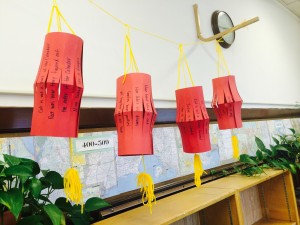 For the month of January we have been learning more about the Chinese New Year through literature and multimedia. This week we are working together to create a culminating list of everything we know about the Chinese New Year. We will write our new knowledge on chinese paper lanterns (in red of course) and hang them in the library for all to share. Our sources include:
For the month of January we have been learning more about the Chinese New Year through literature and multimedia. This week we are working together to create a culminating list of everything we know about the Chinese New Year. We will write our new knowledge on chinese paper lanterns (in red of course) and hang them in the library for all to share. Our sources include:
- The Runaway Wok: A Chinese New Year Tale
- The Great Race: The Story of the Chinese Zodiac
- Taoshu Chinese New Year
- For some K/1 classes, additional information garnered in their homeroom classrooms
In our passports this week we will complete this lesson by adding a horse (2014 is the year of the Horse) to our field journals.
CCSS RL.K.10, RL.1.10, RL.2.10 – Range of Reading and Level of Text Complexity
January 22-24
In Chinese Folklore, the monster Nian scares people. In order to keep Nian at bay, it is tradition to bang pots or drums, light firecrackers and wear red – all traditions for the Chinese New Year. The story of Nian also teaches us to only take what we need and share with others. This week we are watching a brief video, Taoshu Chinese New Year Special, that shares one version of the story of Nian. Winner of the iParenting Award, this brief video will introduce our students to another great Chinese tale. Due to the extended length of this video we will simply place title stickers in our passports this week during checkout and we will not be doing any additional work in our passports.
January 15-17
This week we are continuing our study of the Chinese New Year with the book The Great Race: The Story of the Chinese Zodiac by Dawn Casey. This book, published by Barefoot Books (thanks to parent Rep Alice for facilitating the acquisition of this beautiful book!), tells the story of the Jade Emperor and the race for all animals that was used to identify each of the 12 years in the Chinese Calendar.
After checkout, students added their author/title sticker for the week and wrote down the current year and the sign of 2014 – the Horse. “Horses are popular, independent and fun.”
January 8-10
We will spend the large majority of the month of January learning about the Chinese New Year. This week we began to explore cultural aspects and images of Chinese New Year through the engagine story The Runaway Wok: A Chinese New Year Tale by Ying Change Compestine. Students listened carefully for animals, foods, games/toys and setting details.
After checkout, students added their author/title sticker for the week and completed a step by step drawing of the Wok from the book. Students were then given the choice to draw one of the three items the Wok stole from the rich selflish family and gave to the poor generous family (food, toys, money).
December 18-20
What more could I ask for to culminate the K/1, 1/2 winter unit but a little snow – is that really too much to ask? This week we are working to turn our library into a winter wonderland – a display that this time strapped librarian is hoping will last well into February!
Students are meeting on the rug where we watch one sample snow flake (materials needed include basket coffee filters, scissors, and of course paper bags to catch our clippings). In addition to Ms. Wynkoop modeling the taco, 1/4, pizza fold and making small cuts, we also looked at the Happy Snowflake App on the library iPad to see how the cutys we make translate into snowflake patterns.
After library checkout, we are listening to a specially selected medley of snow and winter songs while we quietly create our one-of-a kind snowflakes and bask in the magic of snowfall. Students are delighted to see their work instantly displayed in the library!
December 11-13
Continuing with our hoping and wishing for snow, we are starting our read aloud with a quick look at The Weather Channel. Is there snow in out forecast? Our story for this week is Snow by Uri Shulevitz. This 1999 Caldecott Honor Book captures the magic and hope of the first snowflake – something that is often made even more magical in a city like Seattle, one that specializes in liquid snow.
Our author/title stickers this week are joined by some lovely snowflake stickers that are falling on the pictures of our houses.
December 4-6
Cold weather and holiday fever often prove difficult for students when focus and attention is required. So, since the meteorologists in our area are predicting snow next week, we are going to focus our reading on snow for the month of December! This week we are reading Brrr! by James Stevenson. Written in a story board or graphic novel format this delightful story gives a grandfather a chance to tell his grandsons about the great snow storm of 1908. So cold that sneezes freeze and they can only find their house by shouting down the tops of trees – homes are completely covered in snow!
Students will add their author/title sticker for the week as well as 3 (not 2 or 5 but…3) snowflake stamps. Following instructions as well as perfecting library proceedures is still very much a focus of our work.
November
20-22
This week we are setting tables (food and books). A strange combo but a metaphor that seems to stick with readers of all ages. Using our book from last week One is a Feast for a Mouse: a Thanksgiving Tale (see below), we are going to set our tables and make choices about what food is good for us and what is not. What does a balanced table look like?
As a group we will do a gallery walk to look at the place settings set before us. To conclude, we will tie our food choices to our reading choices. What books sustain us, give us energy, help us grow as readers? What books are more like dessert and should be limited or seen as treats?
13-15
In our book last week the children stuffed the Turkey’s in their shirts and back on to the school bus to save them from farmer Mack Nugget’s ax. Meals of fruits, vegetables and crackers with jelly were enjoyed by the children, their families and their turkey quests. We talked about why the children might have wanted to “save” the Turkeys.
This week, we are continuing with a theme of choice/sustenance/thanks and are reading One is a Feast for Mouse: A Thanksgiving Tale by Judy Cox. Mouse climbs onto the Thanksgiving Table strewn with leftover tidbits. While he starts with one simple pea (a feast for mouse), he continues to pile on additional items until he comes face to face with the cat!
Making choices about what we need when we eat AND when we read will be our focus for the next two weeks. Students will add an author/title sticker for this week’s book and finish their turkey’s from last week.
6-8
Thematic literature is a great way to expose young learners to theme and informational text through story. This week we read ‘Twas the Night Before Thanksgiving by David Pilkey. In true Pilkey fashion, humor and rhyme abound as a group of school children hop on a bus to visit a Turkey farm.
I began class by asking students to give me hints about what the next vacation/holiday was. Kudos to those who mentioned Veteran’s Day… of course! When given the hint of Turkey I proclaimed the next holiday to be Valentines Day, “I LOVE Turkey!” Prompted to think about having dinner with my family I squealed that my birthday isn’t considered a holiday for everyone but OKAY, if you want to celebrate with me! Once each class talked me in to Thanksgiving we went back over our list of clues – clues we were going to look for as we listened to the story.
A lot of focus has been shifted in school to the Common Core State Standards which clearly articulate how much informational text students should be reading K-12 (yes, there is an App for that!). Sadly, the first jump both teachers and librarians make is that informational has to be non-fiction. Our book by David Pilkey (fiction) told us that:
- Thanksgiving is in November
- the season of Autumn
- we share a meal with our families and friends
- turkeys are often eaten on Thanksgiving
- and much, much, more!
Students finished their work for the day by placing their author/title sticker in their passports and following a step by step drawing of a Turkey.
October
30- November 1
Jasper Rabbitt was seeing Creepy Carrots Creeping Everywhere! This week we read from one of my all time favorite scary stories, Creepy Carrots by Aaron Reynolds. Even though I did read this book with many of the same students last year the cover was met with cheers as we dove into this book that is “fat, crisp and free for the taking” just like the carrots in Crakenhoppen field.
Student each added to the next page in their Passports with an author/title sticker and then proceeded to the libary tables to add their creepiest carrot.
23-25
Book Fair this week! Students are spending 1/2 of our library time checking out books and 1/2 of our time together browsing the selection of books brought to us by the University Bookstore.
In addition to our building hours, you can also shop online to support your Bagley Library. 25% of all sales go directly to adding books to our DBE Library.
Wednesday 10/23 – 3:30-6:30pm
Thursday 10/24 3:30-8:30pm (Literacy Night)
Friday 10/25 – 3:30-6:30pm
16-18
This week we are allowing our imaginations to take hold as we read The Monstore by Tara Lazar. Zack wants to buy a Monster at the Monstore to scare his “pesky little sister,” but quiockly finds out that he is not getting what he paid for – No Returns, No Exchanges. Students used their passports to add an Author/Title sticker for our story and then moved to our tables to draw the Monster of their dreams.
Next week, Book Fair!
9-11
For week 2 in our library passports we are adding a sticker for our read aloud, Scaredy-Cat Splat by Rob Scotton. This young cat wants to be the scariest cat and win an award at school. His sock puppet like spider legs turn out to be not so scary after all. However, when the class is scared silly by a story read by the teacher, the award for scariest cat seems to literally fall right on Splat!
In our passports we also added finger print spiders – following simple 4 step directions for 1) finger print, 2) eyes, 3) 8 legs and 4) a spider’s web.
2-4
We’ve reached out October 1 count and classes size and enrollment has begun to stabilize. That means that we can now dive into our Library Passports! This week students were given their library passports. This is a document we use each week to record what book we read. In addition we often add a drawing, an additional themed sticker or stamp to our passport page. Passports stay in the library for the duration of the school year and will be sent home with students at the end of the year.
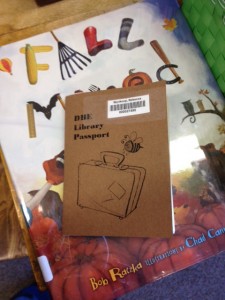 This week we read Fall Mixed Up by Bob Raczka. The ryhming cadence of this book takes us through an Autumn season that is all mized up – Red pumpkins, hibernating geese, and squirrels flying south for the winter! After our story, readers share those things they remember that were all mixed up in the months of “Septober and Octember.”
This week we read Fall Mixed Up by Bob Raczka. The ryhming cadence of this book takes us through an Autumn season that is all mized up – Red pumpkins, hibernating geese, and squirrels flying south for the winter! After our story, readers share those things they remember that were all mixed up in the months of “Septober and Octember.”
Our passports not only help us keep a running record of the stories we share each week but also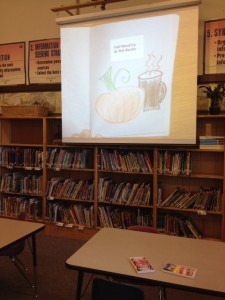 provides regular assessment and review as well as a predictable structure for moving through our time in the library. The librarian provides a reference for students (either on the tables or on the larger screen) for students to refer to if they have forgotten, in the excitement of book selection, what they are to be doing in their passports.
provides regular assessment and review as well as a predictable structure for moving through our time in the library. The librarian provides a reference for students (either on the tables or on the larger screen) for students to refer to if they have forgotten, in the excitement of book selection, what they are to be doing in their passports.
September
25-27
Early Dismissals, Jogathon and other school events have thrown our library schedule for a loop this week. For those classes that were able to come, we introduced the SPS district subscription to Tumble Books. All SPS families have access to this online resource of books, puzzles, quizzes, games, etc. that are great for Elementary aged students – some are even tailored specifically for use on iPads. If you are interested in a Tumble Books username and password, please contact Mrs. Wynkoop. We listened to Big Chicken by Keith Graves.
18-20
Checkout has increased to 2 books. However, if students did not remember to bring their books back they can only check out up to 2 books, total. We will incrementally move towards our delightful goal of checking out 5 books each week but it can be a bit of a slow process. Fortunately, our schedule will remain constant for year. So, if you child has library on Wednesdays now, that will still be the case in June.
We read a fun book with charming illustrations, by Jennifer Sattler, this week. In the book Chick and Pug, Chick wants desperately to grow up to be a WONDER PUG! Chick, in an effort to save his idol from the ferocious cat, Mr. Snuggles, find that even though he is a chick (and not a pug), he can use his words to help his friend.
Part of learning to use the school library has been to come in quietly, sit patiently and wait for instructions. Students have quickly mastered this practice and have begun to look for book independently during checkout time. We are also talking about sharing our library and our books with the whole DBE community. One way we can do this is to use a book mark to keep our place or even remember which book we’ve borrowed. Students were given time, after checkout today, to color a book mark to take home.
11-13 September
What a delight it was to have students so eager to check out books this week. We are reading a very clever story, “Gilbert Goldfish Wants a Pet” byKelly DiPucchio. In addition to reading the book, I have the pleasure of introducing our students to our library pets – Gilbert the goldfish and his buddy Fluffy (our bottom feeding pleco).
We practiced placing our books in the library return boxes. Boxes are placed outside of classrooms in the morning of their library day. Parent volunteers then collect the boxes, check the books in and return all the books to the shelves before students arrive for classes each morning. I am so grateful to have our parent volunteers!
Next week will be our first week to return books. Please be sure to send all the DBE Library books to school with your student(s) on the days listed below:
Wednesday | Green, Moore, Vonderlage, Messom, Forselius and Humphrey
Thursday | Scordas, Bauer, Stackhouse, Bader, Sams and Filep
Friday | Young, Manley, Outhouse, Roos, Stone, Richards and Norton
4-6 September
Welcome Back to the DBE Library! I am delighted to have opened our library with tons of new books and a renewed sense of organization and purpose. Due to new data systems at the District level our circulation of library books has been delayed until the second week of school. This delay, however has provided a unique opportunity to wet the appetites of all our Readers and I am sure we’ll have them ready to go for check out next week.
This week we read The Day the Crayons Quit by Drew Daywalt. Story time in the library guides the use of the library as a community space, helps us practice sitting, listening and being respectful as well as provide an opportunity for students to continue to enjoy great books and build an appreciation for sharing stories.
In addition, to begin our community building and understanding of the library as a community space that is shared by all, we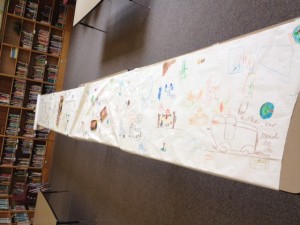 worked as an entire school (during our library time) to add to our mural. Our mural asks students and staff to reflect upon the question, “Where did you read this summer?” Our mural will be posted in the main stairwell for the first few weeks of school.
worked as an entire school (during our library time) to add to our mural. Our mural asks students and staff to reflect upon the question, “Where did you read this summer?” Our mural will be posted in the main stairwell for the first few weeks of school.
2012-2013
June 5 – 13
Puppet Shows! We’ll be turning out favorite books into puppet shows!
Also, please don’t forget to return all your books!
May 29 – June 3
Our year in review starts this week. Students are given time to browse through their passports for the year. Then students turn and talk to their elbow partners about their top two or three books. Through a voting driven process of elimination, each class will pick a story from the school year that they would like to perform as a puppet show.
So far, 3 classes have chosen Who’s On First by Abbott and Costello and one class has selected Dragon’s Love Tacos by Adam Rubin.
May 22-24
Book Fair this week. We’ll be previewing all books. In addition, this week is that last week to check out books. All books must be returned next week.
May 15-20
Did you know that it is the 50th anniversary of the beloved classic “Puff the Magic Dragon?” This week we’ll be looking at how books can sign songs and songs can write books with Peter Yarro and Lenny Lipton’s Puff the Magic Dragon. In addition to reading the book, we’ll also be listening to the song. I’ll have this tune stuck in my head for quite some time, I am sure.
May 8-13
Mystery! In addition to decimating our collection of early reading mysteries (Young Cam Jansen, High Rise Private Eyes, Nate the Great, etc), our readers are listening to The Case of the Missing Monkey by Cynthia Rylant. This short chapter book introduces our readers to the Mystery genre and provides a new access point to our series collections aimed at this age group.
As always, readers are recording this genre in their passports along with an author/title sticker. I am so excited to students to be able to take their passports home and share them with their families at the end of the school year.
May 1-6
Moving along in our genre exploration, students are looking at Realistic Fiction this week. We are adding our author/title sticker for Freckleface Strawberry and the Dodgeball Bully by Julianne Moore to our passports. In addition we are writing “Realistic Fiction: a story that seems real but is made up.”
April 24-29
Science Fiction this week! We are reading Hedgie Blasts Off by Jan Brett. In addition to our Title/Author sticker, students are also recording this week’s genre, Science Ficiton, in their passports. Due to the longer nature of this particular story, our passport work was simplified to ensure completion.
April 10-22
This week we are reading Chimps Don’t Wear Glasses by Laura Numeroff. In our passports we are adding an author/title sticker and writing “Fantasy.” Students are also being encouraged to draw a picture of something fanatical they imagined while we read this story.
April 3 – 8
We are slowly moving our way through different genre’s of literature – primarily found in picture books. This week we are reading Wind Flyers by Angela Johnson and illustrated by Lauren Long. Angela Johnson is a 3 time Coretta Scott King Award Winner and Lauren Long has written one of my favorite series – Originally titled Barnstormers, now Sluggers. In our passports we are adding an author/title sticker and writing “Historical Fiction – a made up story with true history.” Students are beginning to take on greater responsibility with the content and organization of their passports.
Last week as we moved towards greater passport responsibility, I installed plastic page covers in the center of each library table. Each week I place a copy of our passport page inside for students to use as a reference when they sit down to work in their passports. Keeping little fingers from picking at these “windows” is going to a bit challenging!
March 27 – April 1
We are starting class this week with a little rythm and rhyme. Singing Boom Chicka Boom (regular, underwater, western and library style), we are familiarizing ourselves with the rythm and rhyme of of Chicka Chicka Boom Boom by Bill Martin Jr. and John Archambault. Students are placing their author and title stickers in their passports and drawing their own Coconut tree and adventurous letters. At the end of class, having successfully checked out our books and completed our passports, we are having a dance party to two versions of Chicka Chicka Boom Boom AND Boom Chicka Boom.
March 20 – 25
Thanks to author and illustrator Dan Yaccarino for his beautiful and well written biography, The Fantastic Undersea Life of Jacque Cousteau. This week we are reading this book and talking about what a biography is – a non-fiction book about someone’s life. This is a new word for most of our K/1’s. Students are placing an Author/Title sticker in their passports as well as writting, in their own pen, the word BIOGRAPHY. With the remaining space, students are given time to draw their own undersea adventure while we listen and watch The Undersea World of Jacques Cousteau Collection: Sunken Treasure.
March 13 – March 18
This week we are reading One Cool Friend by Toni Buzzeo. This will be the first week that students will be writing in their passports. We are planting seeds for Field Journals in the second and third grades as well as building confidence and independence in the DBE Library. Students will write the author and title in their passports following a sample provided by the librarian. In addition, they will be given and opportunity to draw an animal they would like to bring home from the zoo.
March 6 – March 11
This week we used out listening skills to fill out a roster card for the baseball team in Abbott and Costello’s famous “Who’s on First” comedy sketch. Students in all K/1 and 1/2 classes were able to watch the 6 minute BLACK and WHITE video of Abbott and Costello performing their sketch in the 1940s. In addition, stopping the video twice we were able to fill out our lineup cards for all but center field – based on the video we watched. What a pleasure it is to listening to DBE Readers attempt to recite this sketch while they are waiting in line for checkout!
February 27-March 4
Spring is just around the corner, Spring training has started AND John Martz just published a new book titled “Who’s on First?” by Abbott and Costello. While my delivery desperately pales in comparison to the original, students are easily following my voice, tone, pauses and cues and are laughing at the appropriate times – though, without a partner yelling “Third Base” just isn’t quite the same.
We have begun to use a visual schedule for our library times to help us self regulate our behavior and to better predict what will be happing when, in the library. Students are able to refer to the schedule if they have questions or need to be redirected. We added a sticker for our book this week and a stamp of a bear playing baseball. This week I had a student use their passport to select their books to check out. She went back through her passport and chose Bear Snores On and Mind Your Manners B.B. Wolf. I love it!
February 20-25
Library tour today! Nope, not prosepective families but a celebration and in depth look at our E book collection. Our E books are for EVERYONE! We talked about the alphabetical order and how the libary uses author’s names to put our E books in order. This helps librarians put books away and helps readers find them. Students also practiced using shelf markers when looking for books in the E section of our library.
February 13-18
Who doesn’t love a good old fashioned love story? Students listened and laughed to Adam Rubin’s story, Dragons Love Tacos by Adam Rubin. Students then checked books out, added their weekly author/title sticker to their Library Passports and proceeded to the library tables to add their own taco’s to their Passports. Left to their imaginations, students added some pretty unusual ingredients to their tacos: brussell sprouts, grapes, syrup, blueberries, water, onions, NO cheese and much, much more! When the class was finished and seated at the tables students had an opportunity to project their taco onto the BIG SCREEN and tell their classmates about their creations.
February 6-11
 More Valentines Day this week! We are reading Love, Splat by Rob Scotton. When students add their Author/Title sticker to their passports, they are also writting down their candy heart estimates! In addition, we have moved total checkout for K/1 to 4 books each week. Please help your students/children remember their library books on Library day.
More Valentines Day this week! We are reading Love, Splat by Rob Scotton. When students add their Author/Title sticker to their passports, they are also writting down their candy heart estimates! In addition, we have moved total checkout for K/1 to 4 books each week. Please help your students/children remember their library books on Library day.
K/1, 1/2 and 2/3 have been reading non-fiction materials about Valentine’s Day. In the book Valentines Day by Trudi Strain Trueit, we learned that some people celebrate Valentine’s Day by guessing how many candy hearts are in a jar. So, for the next week students K-5 will hone their skills of estimation to try and win a jar of candy hearts for their classroom. So far our estimates range from 72 to 1,000,000. How many candy hearts do you think are in our jar?
January 30 – February 4
Our library manners Anchor chart is complete and posted. Thanks to our K/1 and 1/2 for coming up with this list of things to remember:
- are polite
- listen with our whole bodies
- share
- say “excuse me”
- keep our bodies to ourselves
- clean up
- come in quietly and respectfully
- are patient
- use a library voice
- raise our hands
In addition this week we began to think about ways that Non-Fiction is different from Fiction. In their own words students shared their own definitions of Fiction and Non Fiction before we read the book Valentines Day by Trudi Strain Trueit. Prior to reading the book, we talked about the FACTS we already knew about Valentines Day. Students were then asked to listen for FACTS that were new to them. After we finished reading the book we shared as many new FACTS as we could remember. Our young readers are great listeners and were able to remember a great deal of detail.
January 23-28
Thanks to B.B. Wolf, we are working on a list of library behaviors. In Mind Your Manners B.B. Wolf, Judy Sierra reminds us to say excuse me and to not bite anyone while at the library. This delightful story weaves elements of other fairy tales into the story of B.B. Wolf who is invited to tea at the library by the lovely Ms. Wonderly. This is an excellent exercise for our first and second grade students who can recognize the visual and textual clues and articulate the connections they are making. Students who figure out that B.B. stands for Big Bad are very pleases with themselves.
When all K/1 and 1/2 classes have given their input with regard to library behaviors we will make another anchor chart to post next to our “DBE Library Books Belong to EVERYONE!”
Time to drill down and indentify our positive library behaviors and celebrate our successes! This week we read D.W.’s Library Card by Marc Brown. This is a story that was read daily in my house until my then 4 year old FINALLY got her library card. We used the book to kick off our discussion of who library books belong to and what we need to do to be responsible library users.
I gathered all K/1 and 1/2 suggestions and used them to create a poster that now hangs in our library. Students were delighted to learn that I was sharing their poster with the 4/5s who have needed a small reminder, as of late.
January 9 – 14
This week we are working on how to listen to a story and follow directions while other activities are going on around us. I have brought two crickets in from home (sadly, food for our newest family member – a leopard gecko). They are in a jar. While I read the story The Very Quiet Cricket by Eric Carle, students get to hold the jar and pass it around. Students are asked to pay attention to the crickets only when they are holding them in their hands – a terribly difficult task but one that most our K and 1 students are tackling with aplomb.
When we are finished with the story, students are given their passports, dismissed for checkout and finish the library visit with a title/author sticker in their passport along with an illustration of a BUG of their choice.
The crickets from home are juvenile crickets and do not make noise. The story by Carle ends when the young cricket grows up and is able to rub his wings together and make a beautiful sound. This book actually opens at the end and plays this sound – to the surprise of many of our younger students.
December 19 – January 7
It couldn’t have been more perfect that there was snow sprinkled on the grouund when I walked to school this morning.  For the last couple of weeks we have been reading winter books (Snowy Day and Waiting for Winter) and looking at our weekly winter report – hoping for snow! What more could I ask for to culminate the K/1, 1/2 winter unit. This week we are working to turn our library into a winter wonderland – a display that this time strapped librarian is hoping will last well into February!
For the last couple of weeks we have been reading winter books (Snowy Day and Waiting for Winter) and looking at our weekly winter report – hoping for snow! What more could I ask for to culminate the K/1, 1/2 winter unit. This week we are working to turn our library into a winter wonderland – a display that this time strapped librarian is hoping will last well into February!
 Students are meeting on the rug where we watch one sample snow flake (materials needed include basket coffee filters, scissors, and of course paper bags to catch our clippings). In addition to Ms. Wynkoop modeling the taco, 1/4, pizza fold and making small cuts, we also looked at the Happy Snowflake App on the library iPad to see how the cutys we make translate into snowflake patterns.
Students are meeting on the rug where we watch one sample snow flake (materials needed include basket coffee filters, scissors, and of course paper bags to catch our clippings). In addition to Ms. Wynkoop modeling the taco, 1/4, pizza fold and making small cuts, we also looked at the Happy Snowflake App on the library iPad to see how the cutys we make translate into snowflake patterns.
After library checkout, we are listening to a specially selected medley of snow and winter songs while we quietly create our one-of-a kind snowflakes and bask in the magic of snowfall. Students are delighted to see their work instantly displayed in the library!
December 12-17
Next week we’ll be turning the library into a winter wonderland. In preparation for this event we are still checking the weather forecast. There is a chance of rain and snow mixed tonight!! We read Waiting for Winter by Sebastian Mechenmoser. It is such a joy to listen to the laughter as Squirrel, Hedgehog and Bear mistake tin cans, toothbrushes and stinky socks for snow!
This week in our passports we upped our anti a little and I asked students to listen carefully to my instructions that included placing 5 (1,2,3,4,5) snowflake stamps in their passports.
December 5-December 10
We are reading a favorite book of mine this week, Snowy Day by Ezra Jack Keats. Did you know that this Caldecott Winning title is celebrating its 50th Anniversary this year? I love the magic and wonder of the young boy, Peter, who tries to take a snowball home in his pocket. Our K/1 and 1/2 classes have really been enjoying the opportunity to share some of their own snow stories!
Students are using their Library passports to place an Author/Title sticker on the next available page along with a winter themed sticker of their choice.
In addition, while we all hope for snow we have been taking a peek at how technology informs our lives (on a very minor scale). We are checking The Weather Channel on my iPhone each week to see if the weather report has changed. Here’s to wishing for the magic of snow!
November 28-December 3
We took a step back from our storytelling this week and read the book Bear Snores On by Karma Wilson. In order to preserve the predicatbility of the K/1 visits to the library we returned to our beloved carpet, read the story and put a sticker and a stamp in our Library Passports.
For our “Celebrating our Reading Lives” promotion this month, students simply have to have their library records up to date (no late/overdue books) to be entered to win one of two reading pillows for November. Congrats to Nathan and Alex (both in K/1 classes) – they were our lucky winners for October.
November 14-26 – Conferences AND Happy Thanksgiving!
We have read and are now watching The Fantastic Flying Books of Mr. Morris Lessmore by William Joyce. This work will serve as the foundation for our storytelling unit that will take place throughout December.
If you are interested in our work in the library to date, please take a minute to read the First Trimester Review (k/1 and 1/2).
November 7-12
This week students were invited to preview the DBE Book Fair sponsored by the Univesrity Bookstore. Students were given the opportunity to make wish lists to share with the loving adults in their lives. I am pleased to report the Book Fair was wildly successful and raised almost $2000.00 for the DBE Library! Of course we checked out lots of great books too!
October 31-November 5
Watching Trick or Treat Folks, last week, kicked off a discussion about storytelling. We will be using The Fantastic Flying Books of Mr. Morris Lessmore by William Joyce to look at different ways stories are told, what audiences they are created for and the formats they are presented in (animation, print, strips, puppet shows, electronic books, etc.). Throughout the months of November and December we will be creating our own story as a class to share with each other and our reading buddies.
Students placed a sticker of a flying book and the author and title of our chosen story in their passports and then drew something they remembered from the book.
October 24-29
Storytelling has been an artform since the dawn of man. Walt Disney, a master storyteller, shares Tick or Treat Folks. This film, from 1952 features hand drawn and colored animation and Donald Duck finds himself on the receiving end of one of the terrible “tricks” he has played on his nephews, Huey, Duey and Louie.
All month we have been reading October/Halloween themed books on the carpet in the library. This week is no different. Our libary baskets are full of great books for our Bagley readers to check out and share with friends and families.
October 17-22
In our reading this week we thought about what type of Monster we would create. We read The Monster’s Monster by Patrick McDonnell. After checkout (students are now allowed up to 3 books in K,1,2) students placed their title/author sticker in their passport and drew their monsters. Our readers have fantastic imaginations.
We are working on placing stickers/stamps/drawings on the “next available page” in our passports. This is a pretty basic page turning task that some stud we read. In addition we often add a drawing, an additional themed sticker or stamp to our passport page. Passports stay in the library for the duration of the school year and will be sent home with students at the end of the year.
This week we read Fall Mixed Up by Bob Raczka. The ryhming cadence of this book takes us through an Autumn season that is all mized up – Red pumpkins, hibernating geese, and squirrels flying south for the winter! After our story, readers share those things they remember that were all mixed up in the months of “Septober and Octember.”
25-27
Early Dismissals, Jogathon and other school events have thrown our library schedule for a loop this week. For those classes that were able to come, we introduced the SPS district subscription to Tumble Books. All SPS families have access to this online resource of books, puzzles, quizzes, games, etc. that are great for Elementary aged students – some are even tailored specifically for use on iPads. If you are interested in a Tumble Books username and password, please contact Mrs. Wynkoop. We listened to Big Chicken by Keith Graves.
18-20
Checkout has increased to 2 books. However, if students did not remember to bring their books back they can only check out up to 2 books, total. We will incrementally move towards our delightful goal of checking out 5 books each week but it can be a bit of a slow process. Fortunately, our schedule will remain constant for year. So, if you child has library on Wednesdays now, that will still be the case in June.
We read a fun book with charming illustrations, by Jennifer Sattler, this week. In the book Chick and Pug, Chick wants desperately to grow up to be a WONDER PUG! Chick, in an effort to save his idol from the ferocious cat, Mr. Snuggles, find that even though he is a chick (and not a pug), he can use his words to help his friend.
Part of learning to use the school library has been to come in quietly, sit patiently and wait for instructions. Students have quickly mastered this practice and have begun to look for book independently during checkout time. We are also talking about sharing our library and our books with the whole DBE community. One way we can do this is to use a book mark to keep our place or even remember which book we’ve borrowed. Students were given time, after checkout today, to color a book mark to take home.
11-13 September
What a delight it was to have students so eager to check out books this week. We are reading a very clever story, “Gilbert Goldfish Wants a Pet” byKelly DiPucchio. In addition to reading the book, I have the pleasure of introducing our students to our library pets – Gilbert the goldfish and his buddy Fluffy (our bottom feeding pleco).
We practiced placing our books in the library return boxes. Boxes are placed outside of classrooms in the morning of their library day. Parent volunteers then collect the boxes, check the books in and return all the books to the shelves before students arrive for classes each morning. I am so grateful to have our parent volunteers!
Next week will be our first week to return books. Please be sure to send all the DBE Library books to school with your student(s) on the days listed below:
Wednesday | Green, Moore, Vonderlage, Messom, Forselius and Humphrey
Thursday | Scordas, Bauer, Stackhouse, Bader, Sams and Filep
Friday | Young, Manley, Outhouse, Roos, Stone, Richards and Norton
4-6 September
Welcome Back to the DBE Library! I am delighted to have opened our library with tons of new books and a renewed sense of organization and purpose. Due to new data systems at the District level our circulation of library books has been delayed until the second week of school. This delay, however has provided a unique opportunity to wet the appetites of all our Readers and I am sure we’ll have them ready to go for check out next week.
This week we read The Day the Crayons Quit by Drew Daywalt. Story time in the library guides the use of the library as a community space, helps us practice sitting, listening and being respectful as well as provide an opportunity for students to continue to enjoy great books and build an appreciation for sharing stories.
In addition, to begin our community building and understanding of the library as a community space that is shared by all, we worked as an entire school (during our library time)
worked as an entire school (during our library time)

